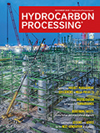Hydrotreating
Marathon Galveston Bay Refinery in Texas (U.S.) to complete hydrotreater repairs in October
The 64,000-bpd residual hydrotreating unit (RHU) was shut by a June 14 fire on the unit.
Digital Exclusive: Mercaptan recombination in naphtha hydrotreating units: A startup challenge
This article presents a case study of a troubleshooting experience at two Saudi Aramco facilities, where a comprehensive investigation was conducted to identify the root causes of the off-spec products. The investigation aimed to develop strategies to mitigate the effects of mercaptan recombination
Blue Water significantly reduces CO2 emissions by switching to HVO in port operations
Blue Water is taking a new step in its efforts to reduce the company's CO2 emissions by introducing hydrotreated vegetable oil (HVO) diesel as fuel for port activities in Esbjerg, Aarhus and Lindø, Denmark.
Marathon Galveston Bay refinery (U.S.) hydrotreater to remain shut until September
A fire-damaged hydrotreater at Marathon Petroleum's Galveston Bay refinery in Texas (U.S.) will remain shut until September, sources familiar with plant operations said.
MAIRE awarded various EPC contracts, totaling $3.5 B
MAIRE announced that its subsidiaries TECNIMONT, KT-Kinetics Technology and NEXTCHEM and have been granted new awards for a total amount of approximately $3.5 billion for engineering and procurement and construction activities related to petrochemical and hydrotreating projects, as well as high value engineering services for a waste to chemical project.
Sensible diesel hydrotreating catalyst selection: An independent catalyst testing approach
This article presents a case study that illustrates how independent catalyst testing was utilized to identify the most effective diesel hydrotreating catalyst.
CVR Energy says fire extinguished at Coffeyville, Kansas (U.S.) refinery
CVR Energy said a fire that broke out in the naphtha hydrotreater unit at a Coffeyville, Kansas refinery operated by a subsidiary has been extinguished.
Marathon restarts hydrotreater at Galveston Bay Refinery, Texas (U.S.)
On Friday, Marathon Petroleum Corp. began restarting the resid hydrotreater (RHU) at its 631,000-bpd Galveston Bay Refinery in Texas City, Texas.
Hydrogen cyanide in amine systems
Mass transfer rate-based simulation has been used to study hydrogen cyanide ingress and accumulation in amine systems in unprecedented detail. In this article, the chemistry, prevention and possible mitigation using water washing arrangements and reflux purging are discussed quantitatively.
Akselos expands structural performance software offering for hydrotreaters
Akselos announced the expansion of its structural performance software offering for hydrotreaters in the refining and petrochemicals sector globally.

- Phillips 66 Limited agrees to acquire Lindsey Oil Refinery assets 1/5
- IIT Guwahati (India) develops sunlight-driven catalyst to convert carbon dioxide into methanol fuel 1/5
- PBF Energy provided an update on efforts to rebuild its Martinez refinery 1/5
- Tasnee's Saudi Ethylene and Polyethylene Co. commences planned maintenance of ethylene plant 1/2
- Advanced Biofuels Canada Association welcomes federal biofuels production incentive coming into force 1/2
- Technip Energies completes acquisition of Ecovyst’s Advanced Materials & Catalysts business 1/2




